SBOS914F October 2018 – April 2021 INA592
PRODUCTION DATA
- 1 Features
- 2 Applications
- 3 Description
- 4 Revision History
- 5 Device Comparison Table
- 6 Pin Configuration and Functions
- 7 Specifications
- 8 Detailed Description
- 9 Application and Implementation
- 10Power Supply Recommendations
- 11Layout
- 12Device and Documentation Support
- 13Mechanical, Packaging, and Orderable Information
Package Options
Mechanical Data (Package|Pins)
Thermal pad, mechanical data (Package|Pins)
- DRC|10
Orderable Information
9.2.2 Additional Applications
The INA592 can be combined with op amps to form a complete instrumentation amplifier with specialized performance characteristics, as shown in Figure 9-5.
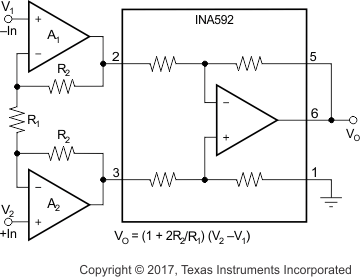 Figure 9-5 Precision Instrumentation
Amplifier
Figure 9-5 Precision Instrumentation
AmplifierTexas Instruments offers many complete high-performance instrumentation amplifiers (IAs). See Table 9-1 for some of the products with related performance.
Table 9-1 Recommended Products to Use
With the INA592
| A1, A2 | FEATURE | SIMILAR TI IA |
|---|---|---|
| OPA27 | Low noise | INA103 |
| OPA129 | Ultra-low bias current (fA) | INA116 |
| OPA177 | Low offset drift, low noise | INA114, INA128 |
| OPA2130 | Low power, FET-input (pA) | INA111 |
| OPA2234 | Single supply, precision, low power | INA122. INA118 |
| OPA2237 | SIngle supply, low power, 8-pin MSOP | INA122, INA126 |
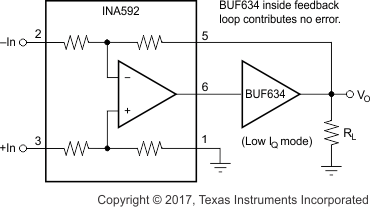 Figure 9-6 Low Power, High-Output Current
Precision Difference Amplifier
Figure 9-6 Low Power, High-Output Current
Precision Difference Amplifier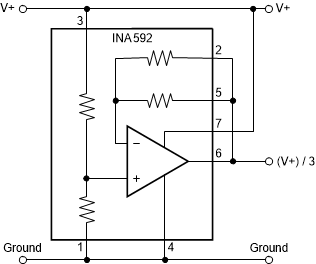 Figure 9-7 Pseudoground Generator
Figure 9-7 Pseudoground Generator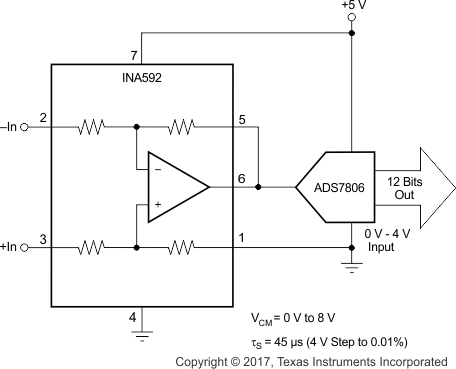 Figure 9-8 Differential Input Data
Acquisition
Figure 9-8 Differential Input Data
Acquisition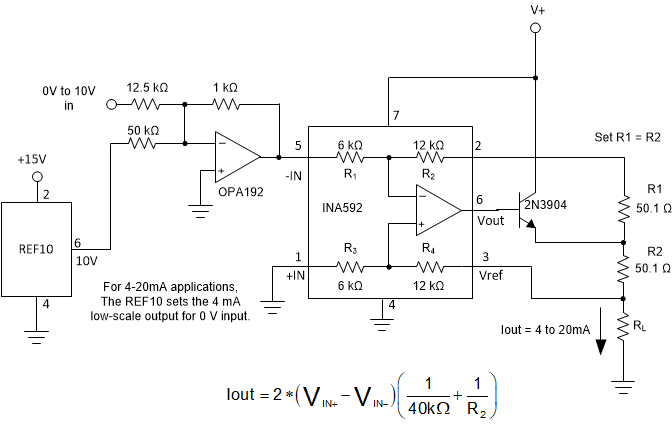 Figure 9-9 Precision Voltage-to-Current
Conversion
Figure 9-9 Precision Voltage-to-Current
ConversionThe difference amplifier is a highly versatile building block that is useful in a wide variety of applications. See the INA105 data sheet for additional applications ideas, including:
- Current receiver with compliance to rails
- Precision unity-gain inverting amplifier
- ±10-V precision voltage reference
- ±5-V precision voltage reference
- Precision unity-gain buffer
- Precision average value amplifier
- Precision G = 2 amplifier
- Precision summing amplifier
- Precision G = 1/2 amplifier
- Precision bipolar offsetting
- Precision summing amplifier with gain
- Instrumentation amplifier guard drive generator
- Precision summing instrumentation amplifier
- Precision absolute value buffer
- Precision voltage-to-current converter with differential inputs
- Differential input voltage-to-current converter for low IOUT
- Isolating current source
- Differential output difference amplifier
- Isolating current source with buffering amplifier for greater accuracy
- Window comparator with window span and window center inputs
- Precision voltage-controlled current source with buffered differential inputs and gain
- Digitally controlled gain of ±1 amplifier